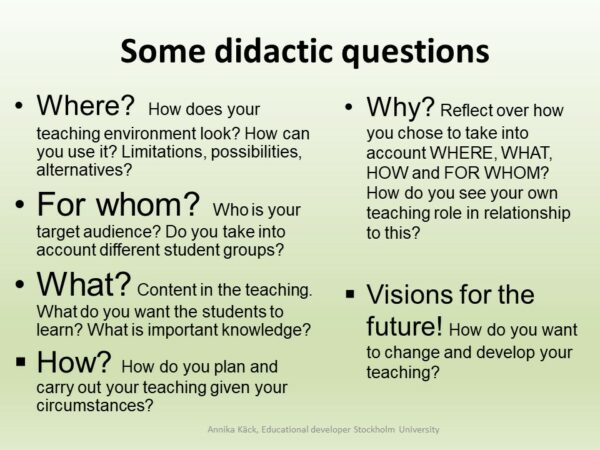Write and reflect over teaching examples
Some universities want you to write your Teaching philosophy and teaching examples separately, while others want you to combine them. Even if you write a combined document you need to gather and update your collection portfolio continually. When you have some interesting examples, write them down and remember to gather evidence that strengthens your examples. In this way you develop yourself as a university teacher and your teaching while at the same time gathering good examples to use as you need them. Concrete examples can be based on a variety of different experiences. It can be a method you use for course planning – from the idea to a complete course, assignments that include greater pedagogical responsibility, effects of teacher training, etc. Here are some examples of questions and different ways to start out when you write down, deepen and analyze your own teaching practice.
The planning of a lesson is a concrete example that you can write down. Reflect on what you do when you plan your teaching, which factors you take into consideration, etc. Describing your own development is also interesting. You can write about your development as a teacher from your first employment until the present. Another developmental perspective can be how you have developed within a specific area, for example as a lecturer, seminar leader.
Different teaching methods are interesting as concrete examples. Reflect on how you teach, for example, at a seminar or a lab from start to finish. Which teaching methods do you prefer? Motivate! You can also think about in which situations certain methods work and why they don’t work so well in others. Do you work with method development or subject didactic development? Do you work with information technology in your teaching? What do you do? How do you work? Motivate and describe what you want to change. When it comes to supervising theses or Ph.D. students you can write about planning and implementation. Think about which consequences your methods have for Ph.D. students?
Knowledge, the content itself, reflect on how students learn and which knowledge they gain through your teaching. You can also write down which content you choose for your students as well as reflect on your choice and also that which you decide not to use.
Production of teaching material is an important part of a teacher’s day. Have you written some learning tools to make learning easier for your students? It can be a PM, an educational study guide, the production of a learning aid.
Pedagogical leadership is qualifying. Think about which subject method development you have helped with, course development where you have been a driving force or reflect over pedagogical leadership administrative tasks you have had.

Läs mer:
- Fenstermacher, G. & Soltis, J (2009). Approaches to Teaching. New York: Teachers’ College Press.
- Trigwell, K. & Shale, S. (2004). Student learning and the scholarship of university teaching. Studies in higher education, 29: 523 – 536.

Think like a researcher
One way to write down teaching examples is to think about it through your knowledge as a researcher. Reflect on how you’ve planned education. Continue to describe how you went about it methodically and which results came from the teaching. Then analyze examples and think about future development. (Katarina Winka and Åsa Ryegård suggest this in their book Winka, K. & Ryegård, Å. (2019). Pedagogisk portfölj: för karriär och utveckling. (2 uppl.) Studentlitteratur AB. [Pedagogical Portfolio for Career and Development.] t is in Swedish.)

A sequence as a reflection model
Annika Käck, educational developer at Stockholm University, has developed a sequence which can be used when you want to reflect on your teaching practice.
Start a log book, preferably digital, where you develop your reflective teaching. Base it on a concrete teaching situation. It can be a seminar, a lecture, a lab, etc. Write down your reflections under each note, or those notes which feel the most important in the instance. In this way you broaden and deepen your critical reflection. Anchor your reasoning in pedagogical theory by studying relevant literature and research.
Continue with the log book. Over time you will be able to compare your teaching with earlier logbook entries and thereby see your development. You can systemize this and see how single teaching methods, mentoring situations, etc. develop over time. You can also develop your course by continually keeping entries in your log book. It’s easy to remember + – ! ? = > and write down your thoughts with different situations.
Reflect on:
+ What did you experience as positive, favorable, constructive, valuable etc. with the teaching moment
– Which negative and unfavorable factors were there? Motivate and deepen your reasoning.
! Did you at some point have an “Aha”- experience? It can either be a positive or a negative experience
? Which questions did you think of as you taught? Did something happen that you need to think about?
= The lesson’s result. Are you satisfied?
> Which future changes will you make? How would you like to develop your teaching?
